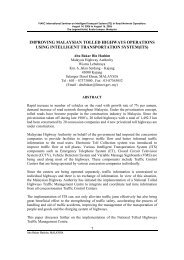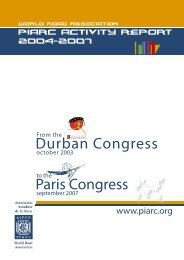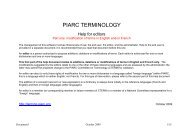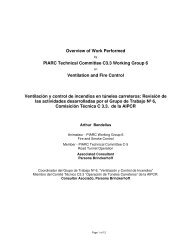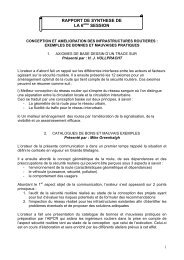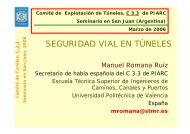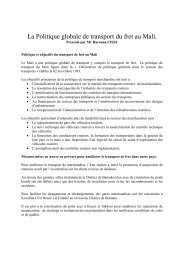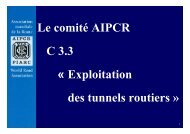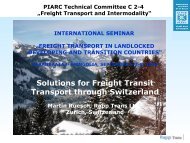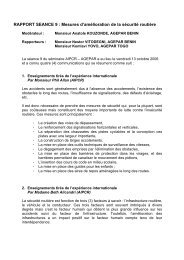Examples of application of the QRA Model (UK, Austria, France)
Examples of application of the QRA Model (UK, Austria, France)
Examples of application of the QRA Model (UK, Austria, France)
You also want an ePaper? Increase the reach of your titles
YUMPU automatically turns print PDFs into web optimized ePapers that Google loves.
<strong>Examples</strong> <strong>of</strong> <strong>application</strong><br />
<strong>of</strong> <strong>the</strong> <strong>QRA</strong> <strong>Model</strong> (<strong>UK</strong>, <strong>Austria</strong>, <strong>France</strong>)<br />
UNITED KINGDOM<br />
In <strong>the</strong> <strong>UK</strong>, <strong>the</strong> <strong>QRA</strong>M has been used for a small number <strong>of</strong> ad-hoc tunnel studies.<br />
Attention has been focussed on comparative risk assessments between routes<br />
and on <strong>the</strong> risks associated with HGV fires in tunnels. The <strong>QRA</strong> study carried out<br />
for <strong>the</strong> proposed A3 Hindhead Tunnel illustrates <strong>the</strong> approach taken. Currently,<br />
<strong>the</strong>re is unrestricted DG traffic and no tunnel on <strong>the</strong> A3 route. Prior to <strong>the</strong> Public<br />
Inquiry for this new tunnel, <strong>the</strong> <strong>QRA</strong>M was used to help answer two questions:<br />
• Should DG traffic be permitted to use <strong>the</strong> tunnel or diverted along a long<br />
distance alternative route?<br />
• Assuming that one bore <strong>of</strong> <strong>the</strong> tunnel would sometimes need to be closed for<br />
short periods for maintenance or following an emergency, should all traffic<br />
from <strong>the</strong> closed carriageway be diverted along a local alternative route or<br />
should <strong>the</strong> o<strong>the</strong>r bore be operated in contraflow mode?<br />
(i) Long term routing <strong>of</strong> DG traffic<br />
The <strong>QRA</strong> model was used to calculate <strong>the</strong> societal risks for <strong>the</strong> tunnel route (A3)<br />
and <strong>the</strong> alternative route, both with and without <strong>the</strong> DG traffic currently using<br />
<strong>the</strong> A3. The contribution <strong>of</strong> HGV fire risks to <strong>the</strong> overall risk was shown to be<br />
important. If <strong>the</strong> risk <strong>of</strong> HGV fires is excluded, <strong>the</strong> overall risk (combining <strong>the</strong><br />
concurrent risks along <strong>the</strong> two routes) appears to be significantly greater when<br />
DGVs are allowed to use <strong>the</strong> tunnel route (option a) instead <strong>of</strong> being diverted<br />
along <strong>the</strong> alternative open route (option b). The Expected Values differ by a<br />
factor <strong>of</strong> about 8. However, if <strong>the</strong> HGV fire risks are included in <strong>the</strong> assessment,<br />
it can be seen that <strong>the</strong>re is no significant difference between <strong>the</strong> overall risks for<br />
<strong>the</strong> two options (A and B). This suggests that <strong>the</strong>re would be no safety benefit to<br />
be gained by diversion <strong>of</strong> <strong>the</strong> DG traffic. Environmental factors also support <strong>the</strong><br />
view that DG traffic should be permitted to use <strong>the</strong> tunnel.<br />
Societal risk results for different route/traffic options<br />
Overall risk, excluding HGV fires<br />
Option a - DG traffic uses tunnel<br />
Option b - DG traffic avoids tunnel<br />
Overall risk, including HGV fires<br />
Option A - DG traffic uses tunnel<br />
Option B - DG traffic avoids tunnel<br />
EV<br />
2.0E-02<br />
2.6E-03<br />
7.7E-02<br />
5.9E-02<br />
EV ratios<br />
EVa / EVb = 7.8<br />
-<br />
EVA / EVB = 1.3<br />
-
(ii) Local diversion route for short term closures<br />
It is expected that one bore <strong>of</strong> <strong>the</strong> tunnel would sometimes need to be closed for<br />
maintenance or following an emergency. Two options were considered for traffic<br />
management under <strong>the</strong>se circumstances. Firstly, all northbound traffic could be<br />
diverted along a local diversion route, allowing southbound traffic to operate in<br />
uni-directional mode in <strong>the</strong> open bore <strong>of</strong> <strong>the</strong> tunnel while <strong>the</strong> o<strong>the</strong>r bore is closed.<br />
Secondly, bi-directional (contraflow) traffic operations could be put in place<br />
through <strong>the</strong> open bore <strong>of</strong> <strong>the</strong> tunnel, with a reduced mandatory maximum speed<br />
limit <strong>of</strong> 30 mph. Using <strong>the</strong> <strong>QRA</strong>M, it was shown that diversion <strong>of</strong> all northbound<br />
traffic along <strong>the</strong> alternative route would lead to slightly lower societal risks<br />
compared to contraflow operations, but <strong>the</strong> absolute level <strong>of</strong> risk would be low<br />
for both options.<br />
Comparison <strong>of</strong> short term local diversion routes
AUSTRIA<br />
In <strong>the</strong> <strong>Austria</strong>n case study, threshold values for tolerable and intolerable risk<br />
have been used for assessing <strong>the</strong> results obtained using <strong>the</strong> <strong>QRA</strong> model. If <strong>the</strong><br />
F/N curve <strong>of</strong> a tunnel is in <strong>the</strong> tolerable risk region, no action is needed. If <strong>the</strong><br />
F/N curve touches <strong>the</strong> intolerable risk region, immediate action is needed,<br />
irrespective <strong>of</strong> <strong>the</strong> costs <strong>of</strong> providing risk mitigation measures. Between <strong>the</strong><br />
areas <strong>of</strong> tolerable and intolerable risk is <strong>the</strong> so-called <strong>the</strong> ALARP region<br />
As Low As Reasonably Practicable). If <strong>the</strong> F/N curve is in this region, <strong>the</strong>n<br />
additional mitigation measures may be required, depending on <strong>the</strong>ir cost<br />
effectiveness.<br />
Tolerable risk as suggested by<br />
<strong>the</strong> <strong>Austria</strong>n Commission for Tunnel Safety<br />
for a 1 km road tunnel<br />
However, <strong>the</strong>se<br />
threshold values<br />
used have no<br />
<strong>of</strong>ficial status<br />
and in future <strong>the</strong><br />
<strong>QRA</strong> model will<br />
probably be<br />
used in a<br />
comparative<br />
step by step<br />
procedure, more<br />
or less similar to<br />
<strong>the</strong> framework<br />
for use <strong>of</strong> <strong>the</strong><br />
<strong>QRA</strong>-model<br />
in <strong>France</strong>:<br />
• Step 1: check <strong>the</strong> relevance <strong>of</strong> <strong>the</strong> problem<br />
• Step 2: investigate <strong>the</strong> tunnel<br />
• Step 3: investigate alternative routes<br />
The next Figure shows a compilation <strong>of</strong> <strong>the</strong> F/N curves for <strong>the</strong> 13 tunnels. The<br />
highest societal risk was calculated for <strong>the</strong> Viennese Kaisermühlentunnel, which<br />
has a traffic volume <strong>of</strong> 85000 vehicles per day (<strong>the</strong> highest <strong>of</strong> <strong>the</strong> 13 tunnels).<br />
The lowest societal risk was calculated for <strong>the</strong> Schönbergtunnel, which has a<br />
traffic volume <strong>of</strong> approximately 8500 vehicles per day. None <strong>of</strong> <strong>the</strong> F/N curves<br />
for <strong>the</strong> analysed tunnels was found to touch <strong>the</strong> area <strong>of</strong> intolerable risk. All <strong>of</strong> <strong>the</strong><br />
F/N curves lie partly or wholly within <strong>the</strong> ALARP region. A range <strong>of</strong> risk mitigation<br />
measures were considered, including diversion <strong>of</strong> DGVs, regulating <strong>the</strong> spacing<br />
between HGVs to a minimum distance <strong>of</strong> 150m and ventilation system<br />
enhancements.
Comparison <strong>of</strong> F/N curves for 13 tunnels in <strong>Austria</strong>
FRANCE<br />
In <strong>France</strong>, so far, quantitative risk analysis <strong>of</strong> dangerous goods transport is<br />
required for all new tunnels, except for non-urban tunnels less than 500m if bidirectional,<br />
and less than 800m if uni-directional. A simple qualitative approach<br />
may be used in o<strong>the</strong>r cases. For tunnels in operation, a <strong>QRA</strong> study is required<br />
only when modifications are planned for <strong>the</strong> dangerous goods traffic, or if asked<br />
by <strong>the</strong> French authorities.<br />
However, after having performed a number <strong>of</strong> <strong>QRA</strong> studies, it was concluded that<br />
a criterion based on tunnel length is insufficient to define whe<strong>the</strong>r detailed risk<br />
analysis is required (<strong>QRA</strong> study) or not (qualitative study). O<strong>the</strong>r parameters<br />
such as <strong>the</strong> traffic characteristics are also important. This can be illustrated by<br />
considering a past case study where tunnel was long enough to require a <strong>QRA</strong><br />
study, but <strong>the</strong> DGV traffic was too low to constitute a significant level <strong>of</strong> risk.<br />
An Intrinsic Risk (IR) criterion has <strong>the</strong>refore been defined, based on past<br />
experience gained using <strong>the</strong> <strong>QRA</strong> model. This criterion corresponds to an<br />
Expected Value <strong>of</strong> 0.001 fatalities per year. The Intrinsic Risk is calculated by<br />
applying <strong>the</strong> <strong>QRA</strong> model to <strong>the</strong> tunnel itself, taking no account <strong>of</strong> <strong>the</strong> adjacent<br />
open sections <strong>of</strong> <strong>the</strong> route. Only <strong>the</strong> eleven dangerous goods scenarios in Table 1,<br />
and not <strong>the</strong> two HGV fire scenarios, are considered.<br />
If IR > 0.001 for a given tunnel, <strong>the</strong>n a <strong>QRA</strong> study is carried out to compare <strong>the</strong><br />
tunnel and alternative routes. When comparing two routes, with Expected Values,<br />
EV1 and EV2, three situations have been defined:<br />
• EV1/EV2 < 3 O<strong>the</strong>r criteria are required to make a decision<br />
• 3 < EV1/EV2 < 10 A sensitivity study is required<br />
• EV1/EV2 > 10 Route 2 should be favoured<br />
When EV1/EV2 < 3, <strong>the</strong> following o<strong>the</strong>r criteria are considered:<br />
• risk aversion;<br />
• accidents without involvement <strong>of</strong> hazardous material; and<br />
• route vulnerability from economic and environmental points <strong>of</strong> view.<br />
<strong>QRA</strong> studies have now been carried out for about 30 tunnels. Of <strong>the</strong>se, <strong>the</strong>re<br />
were 5 cases (19%) with IR < 0.001, 4 cases (15%) with IR » 0.001, and<br />
18 cases (67%) with IR > 0.001. Of <strong>the</strong> <strong>QRA</strong> studies with IR 0.001, <strong>the</strong>re were<br />
significant differences between routes in half <strong>of</strong> <strong>the</strong> cases (11 out <strong>of</strong> 22 cases).<br />
Of <strong>the</strong>se, <strong>the</strong> tunnel route was found to be less dangerous in 2 cases (18%) and<br />
more dangerous than <strong>the</strong> alternative route in 9 cases (82%).
Drawing upon <strong>the</strong> experience gained in <strong>the</strong> previous studies, <strong>the</strong> approach shown<br />
in <strong>the</strong> next Figure has been defined for risk analysis for dangerous goods<br />
transports.<br />
Framework for use <strong>of</strong> <strong>the</strong> <strong>QRA</strong> model in <strong>France</strong>



